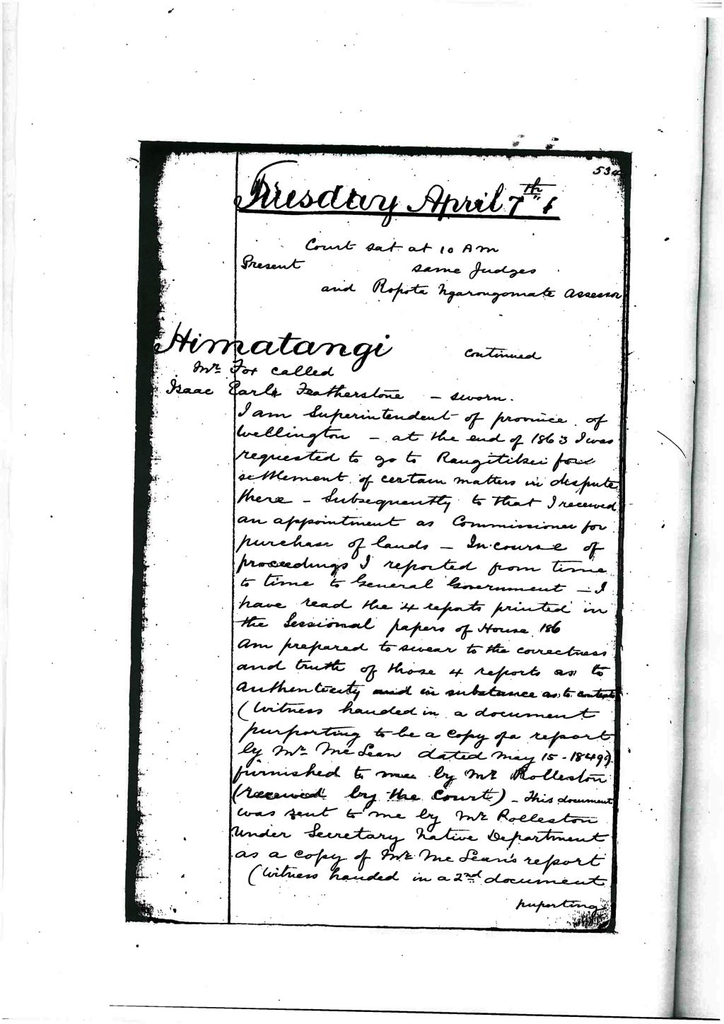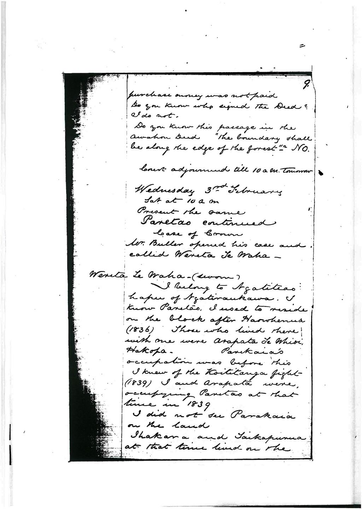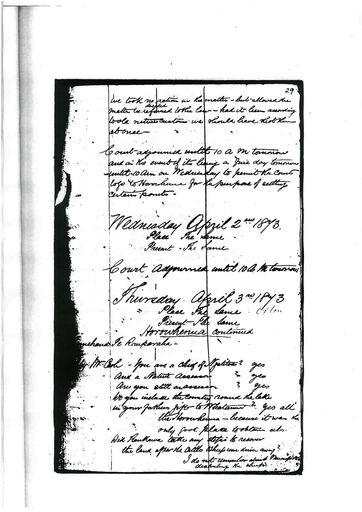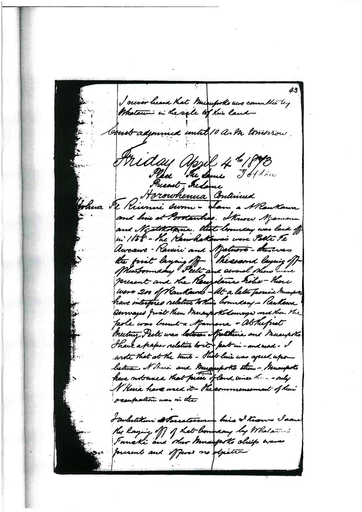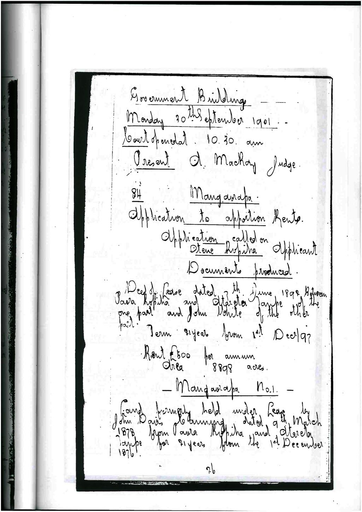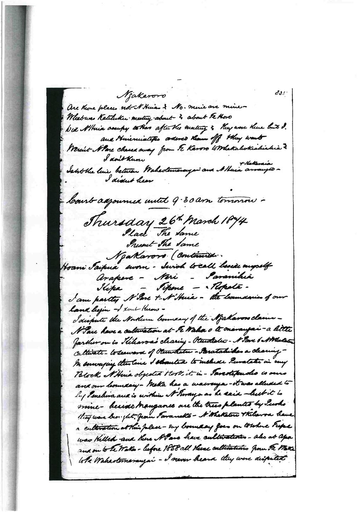7 April 1868
- Description
534-551
Tuesday April 7th
Court sat at 10 am.
Present – same judges and Ropata Ngarongomate – assessor
Himatangi – continued
Mr. Fox called
Isaac Earl Featherstone – sworn
I am superintendent of province of Wellington.
At the end of 1863 I was requested to go to Rangitikei for settlement of certain matters in dispute there. Subsequently to that I received an appointment as commissioner for purchase of lands.
In course of proceedings, I reported from time to time to general government. I have read the 4 reports printed in the Lessional papers of house 186. I am prepared to swear to the correctness and truth of those 4 reports as to authenticity and in substance as to contents. (Witness handed in a document purporting to be a copy of a report by Mr. McLean dated May 15, 1849) furnished to me by Mr. Rolleston (received by the court). This document was sent to me by Mr. Rolleston under secretary Native Department as a copy of Mr. McLean’s report (Witness handed in a 2nd document purporting to be a copy of a letter from Donald McLean dated 16th March) (received – same evidence as to receipt from Mr. Rolleston as true copies of reports).
With reference to a document purporting to be copy of an amended declaration by us filed in the Supreme Court by Izard on behalf of Parakaia served upon Mr. Hart who represented me as defendant, I believe the document produced to be authentic and I believe the word “Received” is in Mr. Hart’s handwriting. The suit was prosecuted in the Supreme Court and the injunction applied for was refused – (document received).
Witness put in a copy of Wellington Provincial Gazette, January 27, 1868 No. 27 containing a report by Mr. McLean to Mr. Fox dated Whanganui April 12th, 1849.
This report is to the best of my belief correctly printed from a copy of Mr. McLean’s report furnished to me by Mr. Rolleston from the Native Office.
Mr. Fox – put in Appendices to Journals of House of Representatives 1864 and 1865 and further papers relating to the Manawatu Block A – N – 4 1866 directing the attention of the court to papers as in list marked (A) – (received).
Mr. Williams – requested that the papers put in, be read.
Mr. Fox stated that – Dr Featherstone was anxious to proceed to Wellington today having important public business requiring his attention and suggested that as the reading of the papers put in would take up the whole day, he suggested that the reading of the papers should be postponed until a future day when Dr. Featherstone could return for examination.
This being assented to by Mr. Williams. Dr. Featherstone left the witness box.
Hunia Te Hakeke – recalled
Xed by Mr. Williams
At the time of the signing of the treaty, I was a child (witness said he was “so high”, about 4 feet). I think I was about 17 years old.
Pikitara was a ‘pa’ of Ngatiapa. I forgot this ‘pa’ yesterday. Pikitara was not ‘whawhaitia e te hoa riri’. Ngatiapa were not ‘mate’. 400 Ngatiapa’s were in the ‘pa’ and they crossed over to the other side of Rangitikei. Turangapito and Te Hakeke left the ‘pa’ because they knew that Te Rangihaeata, Te Pehi, Rawiri Puaha and Tungia had guns. There was a ‘taua na Te Rangihaeata’. They went up to try and take this ‘pa’ from Kapiti. After they had been there some time, we ran away. We were afraid of the guns obtained from the ‘pakeha’. One of our party, an old man, was left behind and killed.
Don’t know of a ‘pa’ called Te Katea.
There were cultivations.
I heard that my mother was taken at Oroua by Ngatitoa – Rangihaeata soldiers. There was no ‘pa’ there. She was ‘noho noa iho’ there. I and my father were at Oahura on Kaikokopu – a fighting ‘pa’ ‘ki oku iwi ano’. Lived there till we went to Parewanui. Lived along the bank and at Tawhirihoe.
At the ‘Kuititanga’ we were collected at Tawhirihoe and Parewanui ‘ki te kura’ and ‘tuhituhi’. We lived sometimes at Parewanui and sometimes at Oahura. It was occupied before and at Haowhenua and afterwards up to the coming of the native teachers from Maungatautari.
We went from Poutu to Waikanae. Our houses were still standing at Oahura. It was occupied by Ngatiapa at the time of Haowhenua. A man named Tipae was killed near there by Tamahiku and Ngatiruanui which was one cause of my coming to fight at Haowhenua. There were no men in the ‘pa’ at the time when Te Whatanui came. They were at Oroua and Whangaehu. The ‘pa’s named yesterday as occupied by Ngatiapa were not occupied at the time when Whatanui came through Rangitikei.
There were 800 men and women at Otakapou – a large island in a lake. This is between Turakina. 200 people at Te Awamate which is on the other side of Rangitikei near the mouth. Some were at Mangawhero near Whangaehu.
When Rauparaha came second time it was to Awamate and the 800 were at Otakapou. I never heard from Turangapito that a ‘pu tangata’ was put (placed) at Whangaehu. He was chief of those rivers. I was not present when the Ngatitoa chiefs gave evidence on these points. If I were told that such a thing was stated to have been done I should say, I heard nothing of it from my ‘matua’s. They only spoke ‘pai’ to one another. The Ngatitoa ‘mana’ was not over the land. We were evilly disposed towards them on account of the killing, at Manawatu, of the woman Waimai by Te Watarauhi Nohorua. When Rauparaha came the 2nd time, he did not go to Otakapou. He came on the coast and stopped at Te Awamate. Don’t know whether he knew of the ‘pa’ at Otakapou.
Ngatitoa ‘mana’. I acknowledge Ngatitoa ‘mana’ at the time of the sale of Te Awahou. Rawiri Puaha and I agreed or I should not have admitted it. The ‘mana’ of Ngatitoa depended upon my acknowledging it to exist. I can’t speak about Ngatiawa but the chiefs of Ngatiawa know very well that they have no ‘mana’. Taranaki might assert a claim. There is a ‘take’ for it. My ancestors were related to that tribe.
I attacked Ngatitoa and he turned upon me. There were 6 tribes fighting against Ngatitoa for 7 years up to the Awamate.
I finished it at Poutu where I killed 20. Takapiti and Te Ngohi were the chiefs of Ngatitoa who went up with the ‘taua’. I had the best of it. This was the last of the fighting. Rangihaeata sent Pikinga to her people to make peace and when Te Whatanui came to Otaki, peace had been restored.
There was no ‘pa’ at Te Poutu. The people were at Te Awamate, Koputaara, Pukepuke and Pikitara . At Te Awamate, Te Rangihauku and Koupeka chiefs, Ngatiapa were killed there.
A ‘kohuru’ by Rauparaha and Rangihaeata – this was to avenge the Waioru (Kapiti). The ‘pa’ was taken. The chiefs were enticed on shore and killed and the occupiers of the ‘pa’ fled. Ngatitoa followed but did not catch them. Hakeke got away to Oroua. The Poutu affair was 6 months after that. Te Ngohi and Te Kapiti were the chiefs who led the party. They thought the Ngatiapa would be afraid of their guns. They were all killed. One was saved. Tohi Ariki was spared and he was afterwards released. Mohi Mahi was the chief. Hakeke was at Pakitara.
Rangihaeata heard at Kapiti that Ngatitoa had been slated and he sent up Pikinga to make peace. At this time the people were at Oahura, 80 men and women, at Pukepuke 50 men and women, the rest were at Otakapou, there were 800, at Pikitara 600.
At the time of the Poutu affair, Ngatiraukawa hadnot arrived but it was near the time of their coming.
At the peace of Poutu, some of Ngatiapa were at Oroua, some along the Manawatu up to the Oroua, some at Whanganui Mangawhero. There was no ‘pa’ at Oroua. They were living on the river and a Te Aunui – an island where they were when afraid of being surprised.
When Ngatiraukawa came, they killed some Ngatiapa and took some prisoners. I heard from my father that there were 60 altogether with Whatanui. After that, other parties of 20’s and 30 came and joined – the fire having been lighted.
Turangapito came after Whatanui to avenge Te Whareki. We did not want peace. Whatanui caught a lot of women and sent them to the Ngatiapa chiefs. I did not want peace. It was Whatanui who wanted peace. Ngatiapa did run away to Wairarapa. Hakeke went to fetch guns from Kekerengu. This was before Te Whatanui came.
Te Rangihauku sent to him Te Kekerengu, not to give Te Hakeke guns. “Your sister has been killed”. Kekerengu believed it, and fired on Ngatiapa. Turangapito did clear out to Turakina when Whatanui came down to leave the road clear. He was ‘tupatu’ of the ‘heke’. The Oroua people ran away in to the bush, hearing that some of their people had been taken and eaten.
Te Awamate was not abandoned nor Otakapou – (2) after Poutu the Ngatiraukawa ‘heke’came. Before this Te Hakeke and Re Rangiteki had gone to Rangihaeata at Kapiti and was there as a guest.
Rangihaeata said, “ka tika to maunga mai i to patu’, but as for Rangitane and Muaupoko, ‘ka mau tonu toku mau ahara’”.
My father, mother and I used to live on the other side of Otaki. Used to bring pigs and mats etc to my friends and when I got blankets and powder I returned to Rangitikei. I was living here a year. This was between ‘Kuititanga’ and ‘Haowhenua’. My father and mother were not ‘kai mahi’ of Matene’s. My father used to come here with 20 men. He was not ordered about by Matene. When I was living here, I saw some Ngatiapa ‘pouonga’ living with Te Rangihiroa. There were not many slaves.
If Tamihana had said that Te Rauparaha had 40 slaves of Ngatiapa, Muaupoko and Rangitane, he would have stated.
Court adjourned at 1 pm for an hour.
Court resumed at 2 pm
Kawana Hunia
Xed by Mr. Williams – continued
When I was living here at Otaki, I don’t know whether Ngatikauhata, Patukohuru and other ‘hapu’s had any Ngatiapa slaves. The slaves I know of were the women who were taken by Whatanui at the island, when Mohi Mahi escaped. These were returned at the time and afterwards while I was living at Otaki.
The Ngatiraukawa were not occupying all the lands of the 3 tribes. They were not living at Rangitikei. Ngatikauhata were not at Oroua. Ngatiraukawa were at Otaki. Ngatitoa at Kapiti and Ngatiawa at Mana and at Waikanae.
Heard of the affair at Waimea. Haowhenua was long after. I and my parents did not live at Otaki before Haowhenua. Two years after Nepia had gone to Rangitikei, my parents came to bring Ihupuni and other presents with 15 people to Matene. Nepia had been living at Te Ana and Matuhiwi and Waituna – 10 men and 10 women – Parewahawaha. Ngatikauhata were living at Oroua at the time I was living at Otaki. Ngatiraukawa were not at Himatangi. They went there when Governor Browne bought the Awahou block. I was then living at Moutoa with Ngati Te Upokoiri. Henare Te Herekau and Whakatere were living at Taita seaward of Manawatu. Ngatiraukawa had a ‘pa’ at Opiki and Whakatere on this side – had not cultivated at Himatangi – from Haowhenua to the sale of Te Awahou. Te Whetu was there but was connected with Rangitane, at the time of Haowhenua.
Remember the time of sale of North Rangitikei. Ngatiraukawa were not living on the Manawatu side of Rangitikei. They had lived at Te Ana after Haowhenua. There was a ‘tupapaku’ a relative of Paora Te Ihiihi buried there. He asked me for money and I gave him a horse. When Ngati Upokoiri returned to Heretaunga, they left the lands to Te Peeti and me and Te Ahu o Turanga to Te Hirawanu - commencing at Te Kaingapipi below Moutoa to Himatangi and on to Puketotara and Oroua. I should say that my ‘mana’ is over the land on this side of Manawatu which was returned by Ngati Te Upokoiri. These lands belong to me and Te Peeti, Te Warena and Huru are the persons in charge.
My father asked Ihakara for a portion of the rent, Te Awahou, to test the good heartedness of Paora Tai Kapurua. Ihakara said there is no money. I did not hear that Ihakara said, “Is it land given to me by you, that you should ask me for a part of the money?”
When I burnt Mr. Robinson’s house, he gave me money. Did not hear Nepia say that he would hold the land (Rangitikei Manawatu block) for Ngatiraukawa and not sell it but after I burnt the house I heard that all Ngatiraukawa said so. It was not Nepia who caused me to have an interest in the lease, it was myself.
On hearing Awahou was sold, I went to Wellington and took money and arranged for the cattle to be placed on the land. When Ngatiraukawa went to build a mill at Makowhai, I (Ngatiapa) went and built a ‘pa’ and took 80 guns. Nepia and Ngatiraukawa went to that ‘pa’. They did not go armed. They were on their way to Taupo. On their return it was proposed that the mill should be built half by Ngatiapa and half by Ngatiraukawa. I took the stones from Nepia’s hands, buried them to see who would come and take them. Some of the old men of Ngatiapa did assent to the proposal to share the mill but what cared I?
Matene Te Matuku is a ‘koroua’ of mine. He has known me from my boy hood. He said I was a bad man for not giving him any of the money I received for his land. Oahuru was a large ‘pa’, there were ‘pou’ – the ‘pou’ were about 8 inches – the 12. They were got from the beach.
It is true that Ngatitoa were ‘patu’ at Te Poutu. Don’t know if any Ngatiraukawa were among them. They were Ngatitoa, Ngati Koata, Ngati Rarua and perhaps some of Ngati Pakau – ‘hapu’s of Rauparaha and Rangihaeata. Did not hear of Ngatiraukawa ‘patu’ing Ngatiapa at Poutu afterwards.
Ngatiapa, Rangitane and Muaupoko are the owners of the land sold to crown. Each tribe knows the boundaries of their own ancestors.
The land returned by Ngati Te Upokoiri belongs to Ngatiapa and Rangitane jointly. There are two ‘hapu’s of Ngatiapa who have special claims – Ngatitai at Himatangi. Peti went to send us away at Tawhirihoe.
It was partly my fault. It was about the money and I said something to offend Kerei. I told the court that if it had not been for Rangitane I would have fired on Ngatiraukawa. I did say to Ngatiraukawa “go back”, “if it comes to fighting with Rangitane but if it is he iwi ke”. I did tell them to go. I could have put an end. If Ngatiraukawa had not been there I would have fired on Rangitane. Kepa and Tamati Puna were looking on.
When Dr. Featherstone came to me, he did not tell me that he had come to tell us that Ngatiraukawa had consented to arbitration. Dr. Featherstone asked me what was on our thought. I said, “Go back to Wellington and ask about the money, £50, which Mawae and Tamati Puna got.
Matene Te Whiwhi did go to Parewanui to try and smooth matters. I saw Parakaia there on horseback at Tawhirihoe.
By Mr. Fox
The mill stones buried have not been fetched from the place where they were buried.
By the court
The mill stones were bought by Nepia and were bought with the proceeds of Te Wharangi.
There were people living at Oahuru at the time of the coming of Whatanui. There were 40 people living there.
The Pikitara affair was shortly before Te Whatanui’s ‘heke’.
A portion of Ngatiapa land is included in Te Ahu o Turanga block. The tribes are mixed up, there are no tribal boundaries.
Further hearing adjourned till tomorrow.
Court adjourned at 5 pm to 8 pm.
Court sat at 8 pm.
Tawaroa No. 1 – Tame Hawea (from pp 533 in this book)
Mr. Hughes
Put in the plan of this land with the alterations required by the court and certificate that the boundary as altered is marked on the ground. Plan received and put with papers.
Tauaroa No. 3 – Parakaia Te Pouepa (from pp 409 this book)
Parakaia – called
Stated that the land was surveyed by Mr. Hughes.
John Hughes –sworn
Produced plan a7 – r1 – p35. Boundaries pointed out by Parakaia – distinctly marked on the ground. Survey conflicts with land claimed by Tamihana and Kiriona which I have ascertained subsequently.
Parakaia Pouepa – sworn
I claim this land. It was forest, felled for a clearing by Te Kuru, Te Raotea, Parekawa, Te Hemara, and others of Ngati Te Au and Ngatirakau.
I planted potatoes there the 1st year. We had a great feast there. Planted 2nd year, 3rd year was the fight with Ngatiawa.
After Haowhenua went to Manawatu. 2 years after came back felled and planted. After this, the land was left until the present time. I claim this land on account of the Kuru, Parakaia, Te Hemara Te Mataaho, Hakopa Te Tehe.
No one cultivated it since. The land on the south west belongs to Ngatihuia and on the south east also to Ngatihuia. On the north east to Ngatipare. The first named boundaries are fixed by myself. The other by Matene Te Whiwhi.
Objectors appeared.
Tamihana Te Rauparaha – appeared - Claimed the greater part of this land – sworn
I know the land in the map. I know the boundaries. Ngatihuia was on one side. It was occupied in the time of Haowhenua by my father. I saw his pegs (Parakaia’s). My father cultivated continually. I cultivated and worked on as well as my wife before and after I went to England.
I took the fence away that was standing on the south west when I went to Whakangutu.
I call Paora as a witness. Tamihana applies to the court to exclude the part claimed by him from Parakaia’s claim.
Xed by Parakaia
The ‘taiepa’ was mine. Rauparaha did cultivate. The stumps are still standing i.e holes may be seen. I cultivated after I returned from England. You have seen my fence going along to the road.
By court
I put up the fence myself with my people. It was put up in 1856. There was not a fence in my father’s time. The fence was an old boundary.
Ratima Potau – sworn
Of Ngatiapa.
I have seen one peg of Parakaia’s on Tamihana’s land. It was cultivated every year. I saw the peg near Te Tauaroa. I recollect the fence. I assistedto put up that fence. It commenced at Tauaroa and followed on to Otaki. This is an old boundary. Only a portion was cultivated.
Xed by Parakaia
I know the cultivation was on the side of the R. You were not my chief. Thompson’s fence ended at the overflow of the river. I cultivated 1 year close to the river. I was not aware it was Parakaia’s land.
Parakaia’s claim was withdrawn by him when he was inforfmed by the court that it was satisfied a certificate could not be ordered in his favor for the whole of his claim.
The objection taken by Tamehana being considered valid.
Case dismissed.
Court adjourned at 10 pm.
Identification
Taxonomy
- Community Tags

